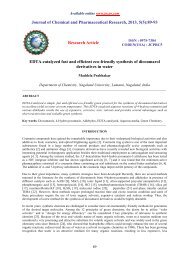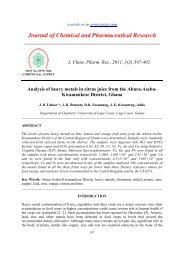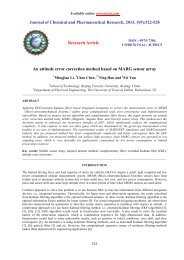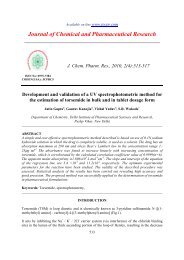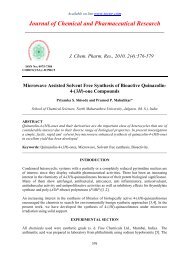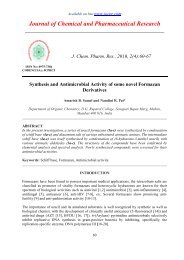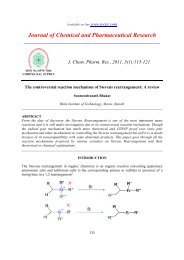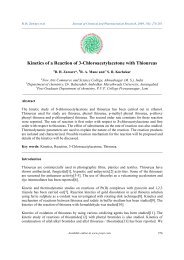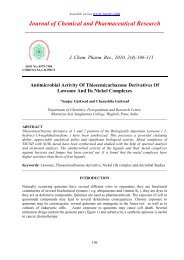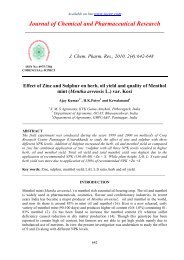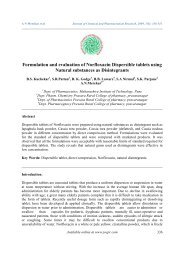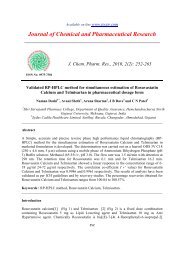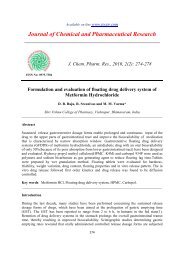Three analytical methods for determination of Epinastine ...
Three analytical methods for determination of Epinastine ...
Three analytical methods for determination of Epinastine ...
Create successful ePaper yourself
Turn your PDF publications into a flip-book with our unique Google optimized e-Paper software.
Ramzia I. El-Bagary et al J. Chem. Pharm. Res., 2012, 4(2):1361-1369______________________________________________________________________________Few <strong>analytical</strong> <strong>methods</strong> were reported <strong>for</strong> the estimation <strong>of</strong> epinastine hydrochloride including HPLC [2,3,and4] andderivative spectrophotometry [4] while epinastine hydrobromide was quantitatively assayed by potentiometricmethod [5].The present study describes two spectrophotometric <strong>methods</strong>, namely difference spectrophotometry and colorimetry,in addition to HPLC method <strong>for</strong> the estimation <strong>of</strong> epinastine hydrochloride (EPH) in bulk and in its pharmaceutical<strong>for</strong>mulation.EXPERIMENTAL SECTION2.1. Instrumentation:For difference method: analysis was carried out on a Shimadzu 1650 PC (Japan) double beam uv-visspectrophotometer connected to IBM compatible computer and HP laser jet 1018 printer. The s<strong>of</strong>tware used wasUVPC personal spectroscopy s<strong>of</strong>tware version 3.7(Shimadzu) with matched quartz cells <strong>of</strong> 1 cm path length .Thespectral band width was 2nm and the wavelength scanning speed was fast.For colorimetric method: measurements were per<strong>for</strong>med using Labomed spectro UV-Vis double beam, scanningauto cell, labomed INC(USA), serial number 001168.For HPLC: a chromatographic system consisting <strong>of</strong> Agilent 1100 HPLC instrument, consisting <strong>of</strong> isocratic pump, anultraviolet variable wavelength detector, an autosampler injector, lichrocart 10 µm C18 column (250 mm×4.6mm),degasser G1322A (S.N.JP05034185), quaternary pump G1311A (S.N.DE14919061), ALS G1313A,(S.N.DE14919455), Col Com G1316A (S.N.DE14928048), VWD G1314A(S.N.JP20217955).2.2. Standards and reagents:All chemicals and reagents used were <strong>of</strong> <strong>analytical</strong> or HPLC grade.<strong>Epinastine</strong> hydrochloride EPH was kindly supplied by Allergan Company (purity 100.31% by HPLC referencemethod ) [6]. Relestat eye drops (0.5mg/ml) (Batch No. E54531), manufactured by Allergen Company waspurchased from the market. Each ml contains 0.5 mg <strong>Epinastine</strong> HCl. Chloranilic acid solution CAA in acetonitrile(1800 µg.ml -1 ) (Sigma-Aldrich), Methanol HPLC grade(lab scan), HCl (0.1N in distilled water), NaOH (0.1N indistilled water), acetonitrile HPLC grade(lab scan), Na 2 CO 3 solution (10%in distilled water), chloro<strong>for</strong>m HPLCgrade, ammonium acetate (0.1 M in distilled water), methylparaben supplied by Pharonia company( purity 98.42%)[7] as internal standard <strong>for</strong> HPLC method.2.3. Chromatographic conditions:Chromatographic separation was carried out on C18 column lichrocart 10 µm (250 mm×4.6mm). Isocratic elutionwas carried out using acetonitrile: 0.1M ammonium acetate buffer (40:60 v/v) at a flow rate 1 ml/min and uvdetection at 262nm. The injection volume was 20 µl. The column was maintained at ambient temperature. Themobile phase was filtered through 0.45µm Teflon membrane filter and degassed <strong>for</strong> about 15 min in ultrasonic bathprior to use. To reach good equilibrium , the analysis was per<strong>for</strong>med after passing about 50-60ml <strong>of</strong> the mobilephase, just <strong>for</strong> conditioning and pre-washing <strong>of</strong> the stationary phase.2.4. Preparation <strong>of</strong> standard stock solutions:a-For difference method: A stock standard solution <strong>of</strong> EPH (0.4mg. ml -1 ) in methanol was prepared.b-For colorimetric method: An accurate weight <strong>of</strong> EPH ( 50mg) was dissolved in distilled water in a 50mlmeasuring flask and transferred into a separating funnel, where 25ml <strong>of</strong> 10%Na 2 CO 3 solution were added. Themixture was mixed and extracted three times each with 25ml CHCl 3 , then the chloro<strong>for</strong>mic layer was evaporated todryness where the obtained residue was dissolved quantitatively in 50ml methanol (final conc. 1mg. ml -1 ).c- For HPLC method: EPH standard stock solution (1 mg .ml -1 ) in methanol and methyl paraben (0.1 mg. ml -1 ) inmethanol as internal standard stock solution.2.5. General procedure and Linearity:a-For difference method:Working standard solutions with concentration ranging from (16- 96 µg.ml -1 ) were prepared by transferringappropriate volumes <strong>of</strong> EPH standard stock solution into two series <strong>of</strong> 5 ml volumetric flasks in duplicate. The1362



